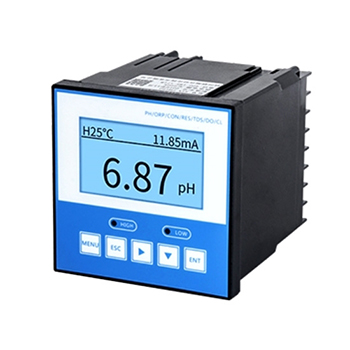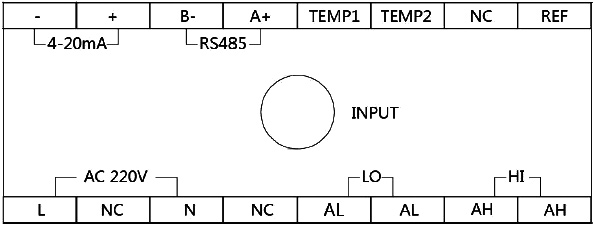How to Use pH Meter?
PH meter, also called acidity meter, is often used to measure and detect the pH of liquid media, and is currently widely used in industries, agriculture, and environmental protection. If the measured data is inaccurate, it will cause serious consequences to the project or the environment, so the correct use of the pH meter is extremely important. When using PH timing, we need to strictly follow the correct method and sequence in order to obtain more accurate measurement data. So let's take a look at the correct steps and working principle of using a pH meter.
How does a pH meter work?
The pH meter uses potentiometric method to measure the pH value of the solution. Therefore, in addition to measuring the pH value of the solution, the pH meter can also measure the electromotive force of the battery. PH is the activity of hydrogen ions in a substance, and the pH value refers to the negative number of the logarithm of hydrogen ions concentration.
The main measuring parts of the pH meter are the glass electrode and the reference electrode, the glass electrode is sensitive to pH, and the potential of the reference electrode is stable. Put the two electrodes of the pH meter into the same solution together to form a primary battery, and the potential of the primary battery is the algebraic sum of the potentials of the glass electrode and the reference electrode.
The potential of the reference electrode of the PH meter is stable. So when the temperature remains stable, the potential change of the primary battery composed of the solution and the electrode is only related to the potential of the glass electrode, and the potential of the glass electrode depends on the pH value of the solution to be measured. Therefore, by measuring the change of the potential, we can obtain the pH value of the pH solution.
Preparations before using the pH meter
- Clean the electrode with distilled water before using the pH meter, and be careful not to break the glass electrode.
- Prepare NAOH solution and HCL solution for adjustment next to the platform pH meter.Take out the fixed pH solution (PH=7.0) in the refrigerator and put it on the platform.
- Turn on the digital pH meter and adjust the PH value, press the ~ key, then the PH and CAL options will appear. Select the CAL item, insert it into the PH solution (PH=7.0), press the《》key to select the data value to 7.0, and then the small eight-pointed will appear.Insert the glass electrode into the solution to be tested, then put in another electrode, and stir the liquid properly (note: do not break the glass electrode).
- The glass electrode socket of the pH meter must be kept clean and dry, and must not be exposed to harmful gases such as salt spray and acid fog. At the same time, it is strictly forbidden to have any aqueous solution on the glass electrode socket to avoid high input impedance of the pH meter.
- When the pH value you need is not reached, you can add Na0H solution and HCL solution (choose different concentrations of adjustment solution according to the adjustment range, add quickly when the concentration is small, and add slowly when the concentration is large).
- Be careful not to exceed the required fixed volume when adding liquid.
PH meter use steps
- Before starting the machine, remove the composite electrode sleeve, clean the electrode with distilled water, and dry the water with filter paper. At this time, do not break the glass electrode;
- Turn on the power and preheat for 5-30 minutes.Unplug the power plug, connect the composite electrode, adjust the switch knob to the pH level, and align the white line of the temperature compensation knob with the temperature value of the solution.

- Turn the slope adjustment knob clockwise to the limit, and insert the previously cleaned electrode into the pH buffer.Adjust the positioning knob to keep the pH meter reading consistent with the pH value of the buffer solution at the current temperature.
- First wash the electrode with distilled water, then wash it once with the solution to be tested, and wash it twice with two liquids before and after.Fully stir the tested solution with a glass rod until uniform, then soak the glass electrode in the tested solution, record the pH value at this time, and the measurement is over.
- In the end, the electrode needs to be cleaned with distilled water, and then the filter paper is used to absorb the water, and the composite electrode cover is put on the pH meter. It should be noted that there should be a small amount of replenishment liquid in the cover.
- Finally, in order to ensure that the subsequent measurement is still accurate, a short wire should be connected after unplugging the composite electrode to prevent dust from entering.
Pay attention when using
Although many people are not unfamiliar with the pH meter and know how to use it, many problems that need attention are still often overlooked. Then let's introduce the relevant precautions of pH meter in detail:
The instrument must be calibrated before use. If the instrument is not turned off, it can be continuously measured, but it must be calibrated once it is turned off, or it must be calibrated once every 12 hours even if it is not turned off. Pay attention to the circuit protection. When the pH meter is not working, its input should be short-circuited to avoid damage.
The glass electrode socket of the pH meter must be kept clean and dry at all times, and must avoid contact with harmful gases such as salt spray and acid fog, and it is strictly forbidden to touch the glass electrode socket with any aqueous solution, which will cause high input impedance of the pH meter. Also pay attention to the storage of the pH electrode, cover the glass probe with a plastic sleeve filled with 3mol/L potassium chloride solution.
Do not touch the glass membrane on the glass bulb with hard objects. When using for the first time, in order to avoid affecting the measurement accuracy due to drying, we need to soak the electrode in 3mol/L potassium chloride solution for about 2 hours.

